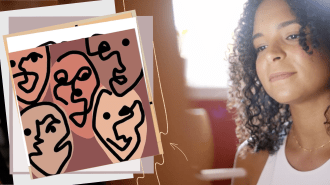Allannah Tiller’s initial aspiration as an artist was to someday land a gallery show. She ended up building much more.
It started with the decision to quit her corporate job and move to Texas with her husband. She had always wanted to pursue art: Vivid images would often pop into her mind and she would want to put them to paper, but the rush of her career left her tired and without the free time.
Now, with no job and more time, she was able to develop her craft. She created figures inspired by pop culture and her environment; her style is minimal and bold, with crisp linework. Soon she started selling her work, mostly paintings and drawings, to family and friends.
Watch the full video on aLILscribble:
Tiller eventually created aLILScribble — an online store where she sells prints, canvases, and stickers of her original artwork. The business model stands in stark contrast to the traditional ways artists have made money, which have been typically limited to selling art through galleries and museums, or working in media and entertainment.
Business was decent. And then, amid the 2020 George Floyd protests that rocked the U.S., Tiller posted a video on social media that went viral. The demand for her artwork soared. When she found herself with over 300 pending orders, she realized it was time to expand her business.
“I was handwriting every single order that would come in, and I really had to pivot the business at that point,” Tiller told Freethink. “When you’re scaling your business, you can’t really just do the same things you’ve been doing.”
From that hand-written order book, Tiller scaled up aLILScribble to an online storefront with wholesale distribution, and her artwork was featured in major retail stores. Not bad for a company of one.
From small to big: scaling a one-person art business with automation
As the internet has grown, solo entrepreneurs have been creating more and more online businesses — a trend that has given rise to the term solopreneur (a solo entrepreneur). According to the U.S. Small Business Administration Office of Advocacy’s 2021 FAQ, 81% of small businesses have no employees.
For Tiller, it’s exactly the kind of career she was looking for, one with the ability to have full artistic and business control at the same time. One advantage of going online is the automated services that are available. Tiller, for example, was able to use an online service to automate her order book and shipping — no hiring necessary.
Automation in business has been growing rapidly since the COVID-19 pandemic. Although some are worried about it replacing jobs, many workers and small business owners welcome the automation of certain aspects of their jobs.
The automation company Zapier reported on the 2021 state of business automation and found that 94% of workers say they perform repetitive, time-consuming tasks (like filing orders) and that 65% of workers said they were less stressed after automating repetitive tasks. In addition, 88% of small business owners say automation allows their company to compete with larger companies. For those involved, automation seems to be helping everyone.
With the nitty-gritty details of aLILScribble automated, Tiller could focus on what she does best: producing art. From there, things took off for her in ways she couldn’t yet imagine.
“I never expected that my work would be at Cannes in France,” Tiller told Freethink. “I never expected someone would fly me out to live draw.”
aLILScribble had become an international success, thanks to Tiller’s entrepreneurial drive and her thoughtful use of social media.
Social media gives art entrepreneurs new angles
When the demand for Tiller’s work soared after her viral post, she recognized that the social media momentum could be short lived, and that she still hadn’t scaled her business. But social media also enabled Tiller to continue talking to her customers and be transparent about how aLILScribble was evolving.
Tiller asked for patience from her customers, explaining how she had started small and now had several hundred times more orders than before. And with that transparency came support from Tiller’s audience: They understood how aLILScribble had grown dramatically and needed time to scale.
Beyond viral content and community management, social media appeals to art entrepreneurs for other reasons — namely by offering a way to exhibit their art to the public and reach audiences that were previously inaccessible.
“Now we have this luxury of social media and these online digital platforms where you can represent yourself, you can show your work to thousands of people who would have never seen it,” Tiller told Freethink.
A study in the Nordic Journal of Media Management aimed to shed more light on how exactly social media benefits art entrepreneurs and artisans. The authors created a three-level framework of reasons to answer the question: the individual level, the firm level, and the societal level.
The individual level includes reasons such as artists being able to communicate with their followers and observe cohorts and competitors. The firm level covers branding and expanding marketing activities, like Tiller seeking wholesale distribution. And the societal level includes reasons like strengthening cultural aspects of their creative works, like Tiller’s viral post on George Floyd. Those are just a sampling of the reasons mentioned in the study and as social media continues to evolve, so will the reasons for using it.
Altogether, social media is an empowering tool for an art entrepreneur, granting access to large audiences and the ability to interact with them. And that communication and transparency proved to be a key factor in aLILScribble becoming a successful business.
Passion, automation, and social media came together and enabled Tiller’s entrepreneurship, and with that, she was able to scale her business into something that could meet her audience’s demand and create a community around her work.
“Entrepreneurship has taught me that I’m a lot stronger than I thought I was, that I can learn anything that I want to learn, and that I’ve got really great people around me supporting me,” Tiller said.
As for advice to aspiring artists?
“Just post your stuff,” she said. “You’re so much luckier as an artist now than a couple years ago.”






